Dust 514 Review
Longtime EVE Online players are well-acquainted with CCP’s indefatigable development process. The Icelandic developer’s spacefaring MMO debuted inauspiciously back in 2003, but a regular dose of free expansions and cosmetic upgrades allowed EVE to not only survive, but thrive, even as other subscription MMORPGs flamed out around it. After a decade of playing the long game, EVE still sees ever-increasing subscription numbers. With their flagship sailing smoothly, CCP has begun looking to diversify their portfolio. That’s a logical enough decision on its own, but few could have predicted that the developer known for cultivating its own “Spreadsheets in Space” niche would choose a first person shooter as its next venture. It’s a bit like a farm equipment company deciding to get into sports car manufacturing.
That shooter, Dust 514, enters an already-overcrowded market. The FPS landscape is dominated by fire-and-forget favorites like Call of Duty and Battlefield, where one can go from pressing the power button, to joining a game, to getting killed, to killing someone else within the span of about 15 seconds. It’s a genre that’s almost custom-built for a short attention span, which makes it an odd match for CCP’s notoriously methodical stylings. True enough, Dust 514 shows many of the hallmarks of EVE: a near-overwhelming user interface, a byzantine star map, a preponderance of menus and charts and all the sorts of things you’d never associate with a game about shooting people in the face.
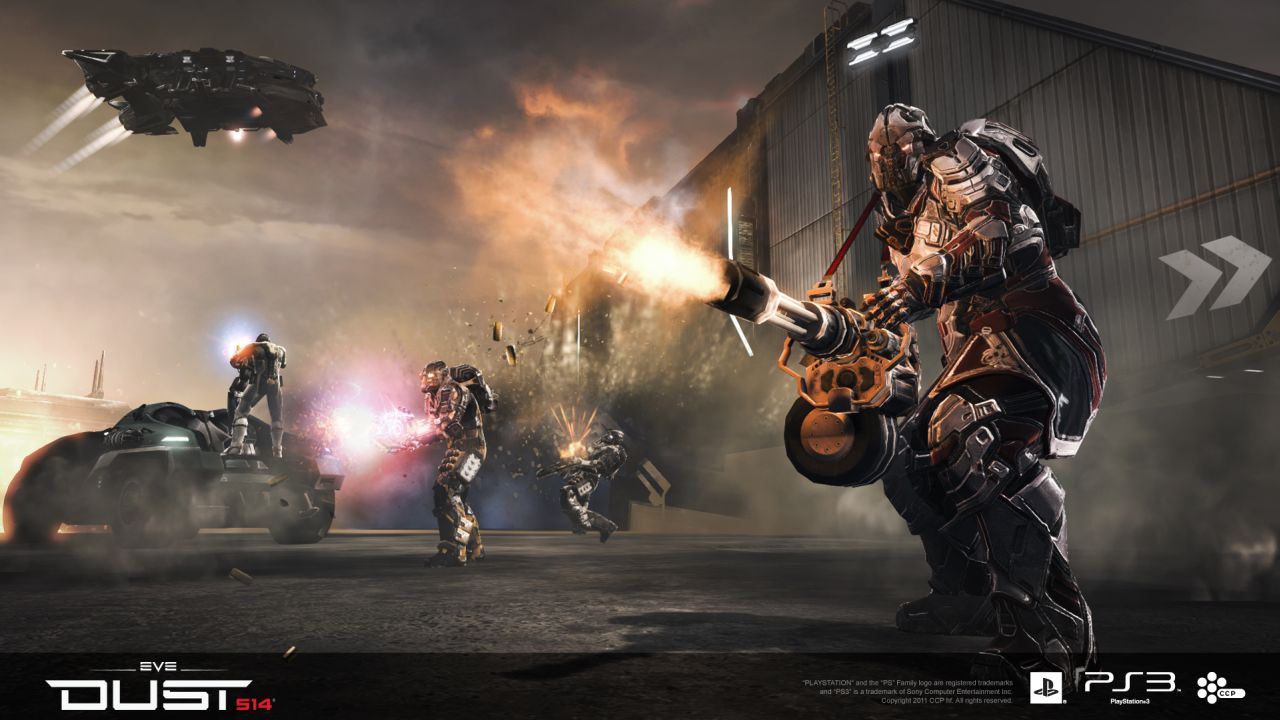
By and large, those eccentricities aren’t the reason that Dust trips up. But trip up it does, mostly due to a staggering lack of polish. Dust 514 feels like a game that’s still a long ways from being feature complete. It’s replete with glitches, balance issues, missing items, shoddy audio, half-baked interface elements, and frame rate problems. Certainly, the game has already seen marked improvement from its nominal beta. Yet the “release date” has passed, and CCP is currently taking microtransaction payments from players to support the game’s free-to-play model, so a judgement must be rendered.
Dust 514’s calling card is its seamless integration with EVE Online and its Tranquility server, a single shard universe where PC-based player corporations trade and do battle for territory and resources. Indeed, the connection is apparent from the opening screen – instead of an artistic splash screen prompting the player to press start, Dust players are greeted with a decidedly PC-esque listing of the latest patch notes and server count, and a reminder that downtime will occur between 11:00 and 11:30 UTC (I’ll save you the trouble of the conversion – that’s 7:00 EST). From there it’s on to character creation, or later, character selection, which offers four playable races straight from EVE: Caldari, Minmatar, Gallente, and Amarr.
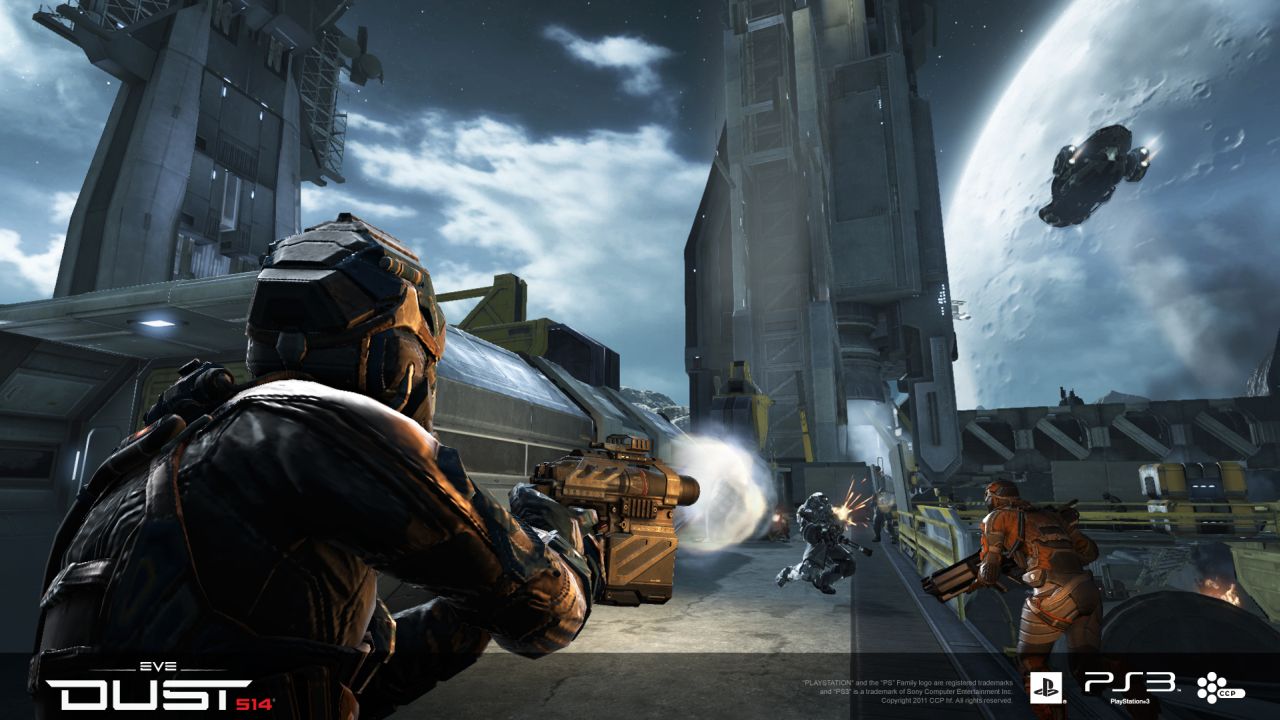
Each has a distinctive aesthetic, as well as an exhaustive amount of lore. Unfortunately, it’s unlikely that Dust’s console players who are unfamiliar with EVE will get much of a sense of the latter. At present, Dust’s integration with EVE is complete only in the most technical of terms. The backstory built up over a decade of EVE Online makes next to no appearance in Dust, nor do the wealth of player histories that have made the MMO such a popular source of public interest stories over the years. Perhaps you’ve seen a few of them online: “Gamer loses equivalent of $20,000 in massive virtual battle” or “Developer implicated in plan to provide resources to leading in-game corporation.” They’re incredibly compelling tales, a dozen television soaps’ worth of drama and intrigue contained on one server. But in Dust you’re a step or two removed from all that commotion that’s ostensibly going on in the skies above you. Player corporations, the life and soul of the EVE universe, are poorly introduced and will remain inscrutable for newcomers. If you’re keen to delve deeper into the mythos that CCP and its players have created, you’ll need to fire up Google.
Perhaps you can do your research while searching for a battle. Your newly created mercenary starts in his own quarters, where he can access his arsenal, visit the market, or dive into an online match. Using either the holographic menus in your tiny cabin, or an overarching user interface, you can browse the star map in search of a battle, or fire up a match. Battles in EVE come in three varieties: “Instant Battles” which were my go-to, “Mercenary” fights that are contracted by an EVE player and are so infrequently available as to be throwaway, and “Corporation” matches that pit Dust/EVE’s versions of player guilds against each other in scheduled engagements.
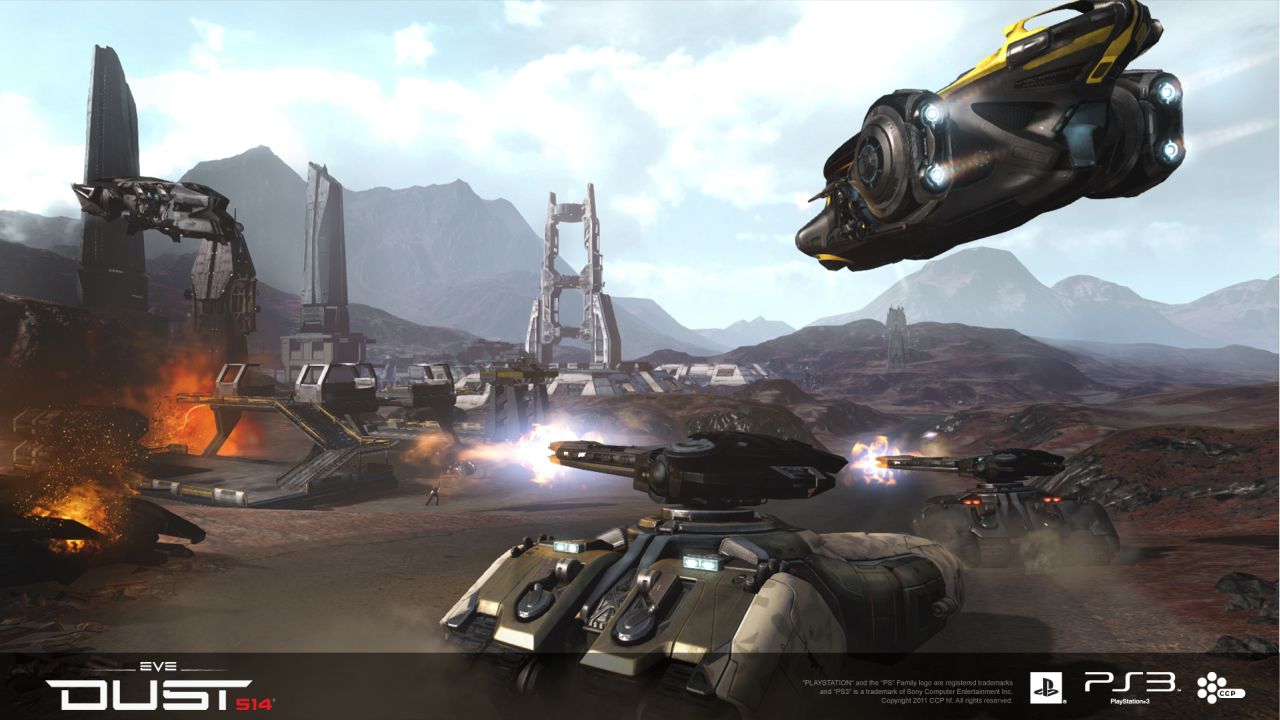
Even Instant Battles aren’t quite, well, “instant”, as it turns out. Choose that particular option and Dust begins a leisurely searching for a fight. Feel free to take some time to browse the market or customize your character’s equipment; it’s entirely possible that the match won’t be available for another minute or so. Get through that wait, and the following loading screen, and you’ll find yourself not in battle, but in another lobby of sorts where you and your teammates are asked to kill another minute or two, whether by walking about or, again, browsing the market or fittings screens. At least there’s local chatting to be done, even if it’s all being done via text.
If you’re wondering why I haven’t just gotten to the part where you start shooting at somebody already, then congratulations, you’re beginning to grasp the Dust 514 experience. One could say that EVE’s massive engagements are won on Reddit and Ventrilo. Dust 514’s battles are won in the market. Or, perhaps more accurately, they’re won in your wallet. Nefariously, the game weds EVE’s impermanent, “all your assets are destroyed forever” consequences of death to a real money transaction system. Factor in the inherent mortality of the average FPS character, and it’s a recipe for a lot of sunk costs. Two currencies run astride each other: ISK, your run-of-the-mill virtual cash, and Aurum, your real money equivalent. Dust is startlingly brusque with its pay-to-win model. Aurum ads litter the marketplace, and powerful, Aurum-only items alternate with regular ones. One would be forgiven for expecting that Aurum purchases be blessed with some staying power, but, should you or they get destroyed, and their number of available uses will decline the same as any other item. One-time use boosters for your ISK or skill points sit alongside the selection of sniper rifles and dropships, tempting you to fish out your credit card.
After you’ve made your purchases, you’ll need to equip them, in a process that requires an undue amount of attention. You’ll first need to ensure that you’ve got the appropriate skill, which means spending ISK to unlock the skill, then attributing earned skill points to its branching list of abilities (each of which needs to be unlocked in turn). Sound unnecessarily fussy? It is, and that’s just the start. Here, EVE’s “fittings” customization system makes the jump from spaceships to “dropsuits”, the name given to your loadouts. Fittings adjust your player’s weaponry, special items, shields, and armor, but you’ll need to pay close attention to your supply of consumables (and…err….”lose-ables”), as well as your dropsuit’s available power and CPU space. It’s a clever calque from EVE’s ship engineering systems, but certainly too clever for its own good. New players will find themselves scratching their heads trying to suss out the minute differences between power consumptions, let alone, say, what their medic syringe’s “meta level” is supposed to indicate.
Everything in order? Then it’s finally time for battle. A warning, though: once you get there, you’ll be dreaming of the pastoral fields of the fittings menu. Combat in Dust 514 is an unmitigated mess, an ugly, imbalanced disaster that aspires to mediocrity and is found lacking. The game’s maps show CCP’s unfamiliarity with the FPS genre. They’re full of unavoidable stretches without cover. They’ve got giant ladders that lead to empty rooms of no strategic import. They’re overly spacious and lack any points of interest, so it’s easy to get turned around and mistake one generic oversized gray box for another generic oversized gray box. Not only are they dull, but their repeated industrial sameness has a dampening effect on the notion that you’re a planet-hopping interstellar mercenary. Instead, you’re just fighting over sci-fi crates on a dusty plain, or on a metal expanse, or on a different-colored dusty plain.
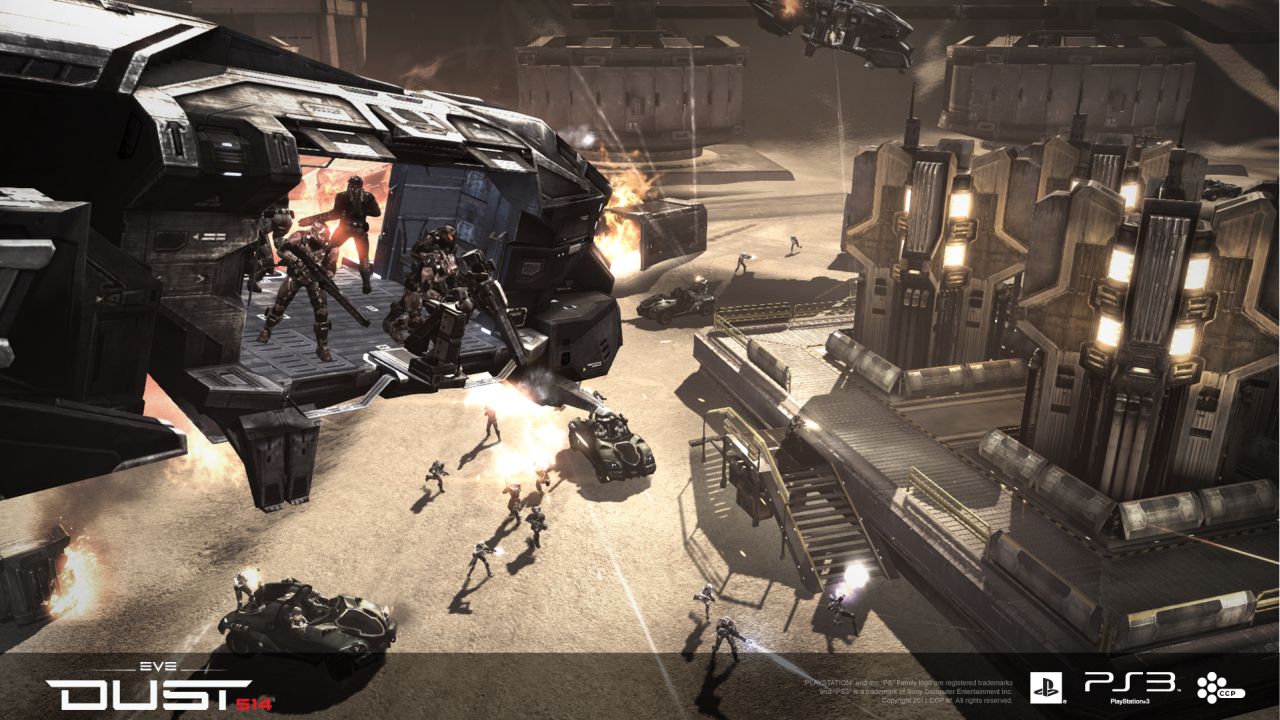
If you’re fired upon while trying to orient yourself, you’ll be hard-pressed to figure out where it came from. Dust’s sound effects are among the worst I’ve ever experienced in a release – the game’s future weapons sound like card shuffling machines when fired, and the noise of incoming rounds has no discernable relationship to location or proximity. What it does have, is an uncanny resemblance to a person making “pew pew” noises. The game has a tendency to provide misleading hit indicators that cause me to spin about in search of phantom enemies. What’s most glaring is that Dust 514’s frame rate runs well under 30 frames per second, consistently, a fact that one finds themselves acutely aware of when trying to snipe a distant figure that’s flitting around the screen in stop-motion. At a distance, bullet tracers look a bit like the aliased lines of color that my old Commodore 64 used to represent laser fire. UI text has a vague fuzziness to it that makes it hard to parse, and about half of what’s on-screen at any given moment is too small to read without making a truly concerted effort of it.
There’s little in the way of good news. It’s easy to get trapped in the environment. Freezes and lag are frequent occurrences. Vehicles are sluggish and dull to pilot. The available battle modes are a lazy assemblage of genre mainstays like team deathmatch and capture the location. A great many of the weapons and crafts on hand are badly underpowered, especially when stacked up against Aurum-only counterparts. Using the aforementioned sniper rifle feels like an uphill battle against the frame rate, and the shotgun is about as useful as you might expect when most engagements take place football fields apart. At least the after-battle report is nice to look at, even if you can’t sell any of the loot you salvage from it – that part hasn’t been implemented yet.
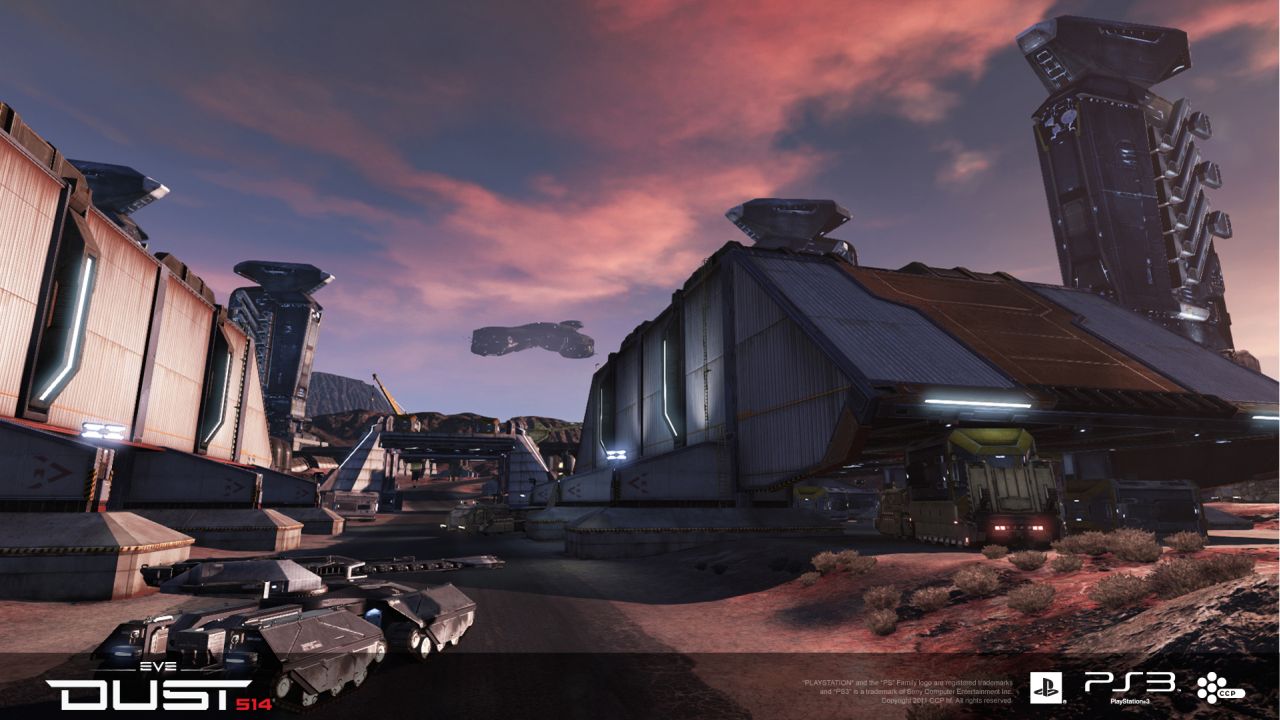
CCP’s innovative touches do crop up here and there, like budding plants in industrial rubble. I’ll cop to a certain fondness for the creepy, new-age tracks that the game, like EVE, employs. And while the dull environments and technical limitations don’t put CCP’s best foot forward, there is some excellent craftsmanship here and there. The weapons in particular are spectacularly designed objects that are markedly different from typical sci-fi fare. They’re asymmetrical, and they avoid conventions about what a shotgun or a grenade launcher are “supposed” to look like while still feeling vaguely tangible. Ditto for the dropsuits themselves, which make every character look like a fearsome future soldier while simultaneously feeling uniquely “of” their race of origin. But little flourishes like these are drowned out by the din of the other issues that scream out constantly.
It’s a real pity. For as cumbersome and unwieldy as Dust 514 is, CCP’s methodical and large-scale approach to the FPS is certainly a change of pace from the usual suspects. I’d just like to see it better realized. Perhaps one day it will be. Lamborghini started out making farm equipment, I hear.
